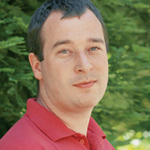Essay: Glen White
 Photo: Diana Rogers, SLAC |
Becoming an accelerator physicist
First, let me come clean. I started off my research career as a particle physicist working for the University of Lancaster in the United Kingdom. My PhD years were spent searching for rare and unseen types of events in data taken by the H1 detector at the HERA electron-proton collider at the Deutsches Elektronen-Synchrotron (DESY) in Germany. Like many particle physics students, my knowledge of what actually went into generating the data that magically filled the databases I used for my research was somewhat limited.
My only real interaction with the world of accelerator physics was to occasionally phone the HERA control room and ask them if they could please "turn up" the luminosity. I could maybe envision a maximum of three tools an accelerator operator could possibly need: a joystick to keep the beams in collision, a luminosity dial, and, of course, an on/off button!
My transformation into an accelerator physicist began during the final months of my PhD. It was the summer of 2000 when I was introduced to Phil Burrows (now one of the spokespersons for the UK International Linear Collider project) at the annual UK Institute of Physics particle physics conference in Edinburgh. I listened for a while about a new project that Phil was starting up to research and design a fast feedback system to maintain beam alignment at the interaction point of the Next Linear Collider (NLC), an American design for a future collider. The linear collider project was already at a very mature stage by this point with many physicists in America, Europe, and Japan having made solid progress on their respective designs for over 15 years.
In the United Kingdom, however, I would initially be the only postdoctoral fellow working on Linear Collider accelerator research, a fact that worried me. The United Kingdom had been out of the game of research on next-generation high-energy frontier accelerators since the creation of the European particle physics laboratory, CERN, in the 1950s. What Phil and others were proposing was, in effect, to re-start this industry in the United Kingdom in order to participate in the design and operation of a linear collider, which was globally accepted among particle physicists as the number-one-priority machine to be built to take the high-energy particle physics field forward in conjunction with, and beyond, CERN's Large Hadron Collider.
Partly due to the very excited sales pitch I got from Phil, the desire to try something new, and the exciting possibility of getting in at the ground level of such an important and interesting project, I put my doubts aside, took the plunge, and tried for the job. My first task was to attend the CERN Accelerator Summer School in Greece. I finally learned that there is somewhat more to building and running a particle accelerator than I ever imagined. In fact, I came away convinced that there is no way on Earth any group of mortals could actually make one of these things work at all!
But here I am 5 years later, happily working on the International Linear Collider (ILC) project. I am currently based at Stanford Linear Accelerator Center (SLAC), home of the world's only high-energy linear collider. Working here brings into clear focus the challenges that lie ahead when one contemplates the leap from SLAC's 90-GeV, 2-mile accelerator to one that could be 15 times longer, over a factor of 10 higher in energy, and provide over 10,000 times the luminosity. With such a dedicated and experienced group of accelerator physicists and such strong backing from the global physics community, I truly believe there is every chance that, given the opportunity by the world's funding agencies, the ILC can achieve every design goal.
One of the many things that keep me so involved and interested in this project is the fantastic sense of truly global cooperation. After the decision to use superconducting technology by the International Technology Recommendation Panel, I was amazed at the speed with which the worldwide community pulled together to start work on the unified goal of design and construction of a truly global International Linear Collider.
If I am fortunate enough to work on the ILC through to its conclusion, it could dominate most of my working life. But if it achieves only a small fraction of the expected, and maybe even some unexpected results, then I think it will have been worth every bit of effort by everyone involved.
Glen White, SLAC
Glen White is an accelerator physicist from Queen Mary, University of London, working for two years at Stanford Linear Accelerator Center on International Linear Collider design.
Click here to download the pdf version of this article.


